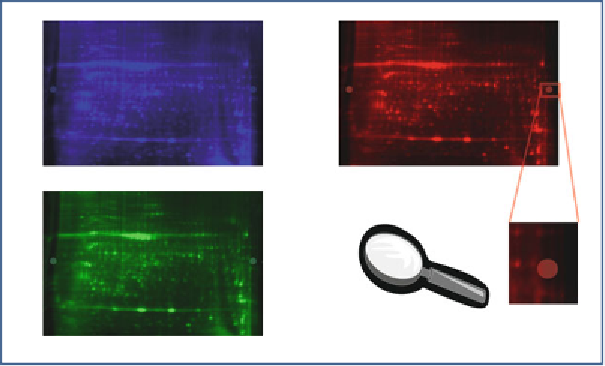Biology Reference
In-Depth Information
a
b
c
d
Fig.
1
Visualization of proteins extracted from red cabbage leaves and labelled with (
a
) Cy2 (in
blue
), (
b
) Cy3
(in
red
), and (
c
) Cy5 (in
green
). (
d
) Represents a magnifi ed area of the gel, carrying the reference markers (
see
Subheading
2.3
,
item 7
, and
Note 14
)
The gel-approach includes different steps: extraction of proteins,
separation by 2DE, visualization of the gels, software-based analysis,
and fi nally cutting of the spot out of the gel before the identifi cation
by mass spectrometry and database search. More or less 10 years
ago, a technique called difference gel electrophoresis (DIGE,
see
Fig.
1
) allowed an important improvement in the quantifi cation
results [
7
,
8
], reducing gel-to-gel variations by the introduction of
internal standard and sample multiplexing on the gels.
Trees are of course of economic and ecological importance. In
plant science, they also bring their specifi c features in order to
improve our understanding of plant life cycle. Indeed, contrarily to
herbaceous, woody plants have to endure the four seasons and to
adapt their life cycle to particular conditions. Therefore, they are
used to study dormancy, bud burst, seasonal senescence, and so
on. For economic aspects, they can be used for phytoremediation
studies, for yield study related to stress conditions, for response
towards pests, and so on. Proteins give a good picture of what is
happening in plants under specifi c conditions, and therefore com-
bining tree studies with proteomics can improve our understand-
ing of their involvement in plant's metabolism.
2
Materials
In our laboratory, the equipment comes from GE Healthcare,
Tecan, and Serva, but many other suppliers with equivalent equip-
ment can also be considered.

